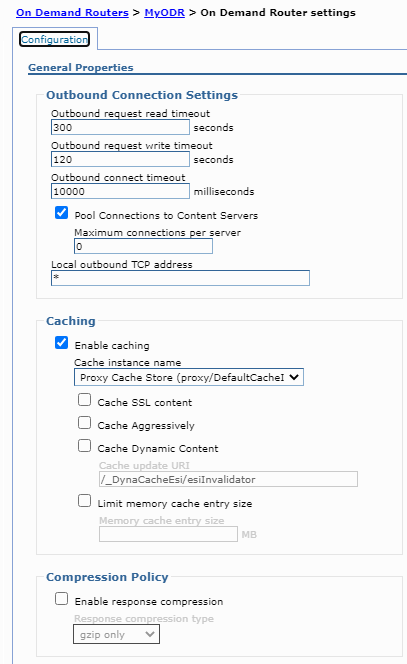Excessive request timeout health policy target timeout value
The excessive request timeout health policy specifies an acceptable percentage of requests that can time out after being routed from the on demand router (ODR). For each control cycle of the health controller, the number of requests that time out after being routed from the ODR is examined. If the percentage of timed out requests exceeds the configured percentage, runtime tasks are generated to correct the situation.
If we enabled Intelligent Management for the web server, the timeout value is determined using the read/write timeout in the web server plug-in cluster properties (serverIOTimeout in the plugin-cfg.xml file). The health policy calculates the percentage of timeouts over a 60-second interval.
By default, the target timeout value for requests is 60 seconds. The default value for the percentage of requests that can time out in the excessive request timeout health policy is 5%. However, setting other properties in the environment can affect the target timeout value used.
Settings that affect the timeout value
The following settings in the console affect the target timeout value:
- ODR outbound request timeout setting
-
Servers | On demand routers | ODR_name | On demand router properties | On demand router settings

...and set the ODR outbound request timeout value to a number of seconds.
- goodServiceTimeLimitSpec custom property
- timeoutFactor custom property
- Average response time value defined in the service policy
-
Operational policy | Service policy | service_policy_name

Specify Average response time as the Goal type and enter a Goal value.
Determine the target timeout value
Depending the configuration, the timeout value used as target value for the excessive request timeout health policy can vary. The following decision tree helps you determine the target timeout value for the environment. The default setting is the path indicated with red arrows, or a target timeout value of 60 seconds, which is the default setting for the ODR outbound request timeout.
Figure 1. Target timeout value decision tree.
The settings that affect the target timeout value combine together to indicate the target timeout value.
- The value of the goodServiceTimeLimitSpec custom property is used as the target timeout value if the goodServiceTimeLimitSpec custom property is specified and is larger than the ODR outbound request timeout value.
- The value of the ODR outbound request timeout setting is used as the target timeout value if the goodServiceTimeLimitSpec custom property is not specified, the timeoutFactor custom property is not specified, and the ODR outbound request timeout setting is set to less than 60 seconds.
- The default value of 60 seconds is used as the target timeout
value if the goodServiceTimeLimitSpec custom property is not specified, the timeoutFactor custom property is not specified, and the ODR outbound request timeout setting is set to greater than 60 seconds.
- The timeout value is set to WebSphere of the values of the timeoutFactor custom property and the average response time of the service policy if the goodServiceTimeLimitSpec custom property is not specified, the timeoutFactor custom property is specified, and the goal type of the service policy is set to average response time.

Related
Health managementCreate health policies
Manage runtime tasks
Intelligent Management: autonomic request flow manager custom properties